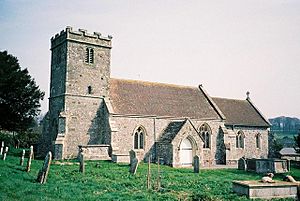All Saints' Church, Tarrant Keyneston facts for kids
Quick facts for kids All Saints' Church |
|
|---|---|
 |
|
| Religion | |
| Affiliation | Church of England |
| Ecclesiastical or organizational status | Active |
| Year consecrated | 1853 |
| Location | |
| Location | Tarrant Keyneston, Dorset, England |
| Architecture | |
| Architect(s) | Thomas Henry Wyatt |
| Architectural type | Church |
| Architectural style | Perpendicular |
All Saints' Church is a historic church located in the village of Tarrant Keyneston in Dorset, England. It is a Church of England parish church, which means it serves the local community. Most of the church was rebuilt in the mid-1800s, specifically between 1852 and 1853. However, its tall tower is much older, dating back to the 15th century! This church is also a Grade II* listed building, which means it's a very important historic building that needs to be protected.
Contents
A Look Back: Church History
A church has stood in Tarrant Keyneston for a very long time. Records show that a church existed here as early as the 14th century, with the first known church leader, called a rector, recorded in 1317.
Why the Church Was Rebuilt
By the mid-1800s, the old church building was in poor condition. It was falling apart and wasn't big enough for everyone who wanted to attend services. So, the community decided it was time to rebuild most of the church. They chose a famous architect named Thomas Henry Wyatt from London to design the new building.
The plans included adding a new section called a north aisle. This would make the church larger and provide more space for the people attending. At that time, about 320 people lived in the area, and the new church was designed to hold 280 people comfortably.
How the Rebuild Was Funded
Rebuilding a church costs a lot of money! The total cost was about £1,500. A large part of this money came from Sir John J. Smith, who owned the local manor house. The local rector's son, Rev. Henry Austen, also gave £300.
Other groups helped too. The Salisbury Diocesan Church Building Society gave £100. The Incorporated Church Building Society gave £70, but they had one condition: 209 seats in the new church had to be free for poorer people to use. This meant everyone, no matter their wealth, could attend services.
Building and Consecration
Permission to take down and rebuild the church was given in 1852. The entire church was rebuilt, but the old 15th-century tower was kept and repaired. The construction work was carefully watched over by the architect, Thomas Henry Wyatt.
The new church was finished and officially opened on September 23, 1853. The Bishop of Salisbury, Edward Denison, led the special ceremony called a consecration.
Later Changes and Repairs
Over the years, All Saints' Church has had more updates:
- Around 1912, the churchyard, which is the area around the church where people are buried, was made larger. The church tower also received some repairs.
- Around 1914, three new bells were added to the church tower. These bells were a special gift in memory of the rector at the time, Rev. Philip Wingate.
- Around 1970, the pulpit, which is where the priest stands to give sermons, was rebuilt. A new roof was also put on the tower.
Church Design and Features
All Saints' Church is built from local stone and flint, with special decorative stones from Bath. The roofs are covered with tiles. The church has several main parts: a nave (the main area where people sit), a chancel (the area near the altar), a north aisle, a north vestry (a room for the clergy), a south porch, and the west tower.
The Tower
The most ancient part of the church is its 15th-century tower. It has two levels and a decorative top edge called an embattled parapet. The tower has four bells. One of these bells is from the 15th century, making it very old! The other three bells were added in the 20th century.
Inside the Church
When the church was rebuilt in 1852–53, many new items were added inside:
- A new pulpit (where sermons are given) was installed. It is shaped like an octagon and made of wood.
- A new font (a basin used for baptisms) was also added. It is made of stone and is also octagonal.
- An organ was built in 1853 by a company called Gray and Davison from London.
- The communion table is very old, dating back to the 17th century, though its top part was replaced in the 19th century.
- The decorative wrought-iron communion rails were added in 1906.
Stained Glass Windows
The large window at the east end of the chancel originally had beautiful stained glass. This glass was made by William Miller of London and given to the church by Rev M. Smith Marriott. The windows on the south side also had stained glass, made by James Powell and Sons.
However, these colorful windows were replaced with plain glass in 1942. The lead holding the stained glass together had become very damaged, and it was too expensive to fix.
Churchyard Monuments
The churchyard at All Saints' Church is a peaceful place where many people are buried. Several old stone tombs in the churchyard are also considered historic monuments and have been Grade II listed since 1986. These include tombs for:
- Members of the Bastard and Barfoot families, including architects Thomas Bastard (who died in 1731) and John Bastard (who died in 1778).
- Members of the Clapcott family, from 1789.
- F. Benjafield, from 1791.
- Members of the Clapcott and Williams families, from 1805.
- James Mayo and others, from 1822.
- Joseph Scormy and Isaac Randall, from 1844.
- Susan Adelaide and Frances Sarah Baverstock, from 1849.
- Elizabeth and Rev. Henry Austen, from 1865.

